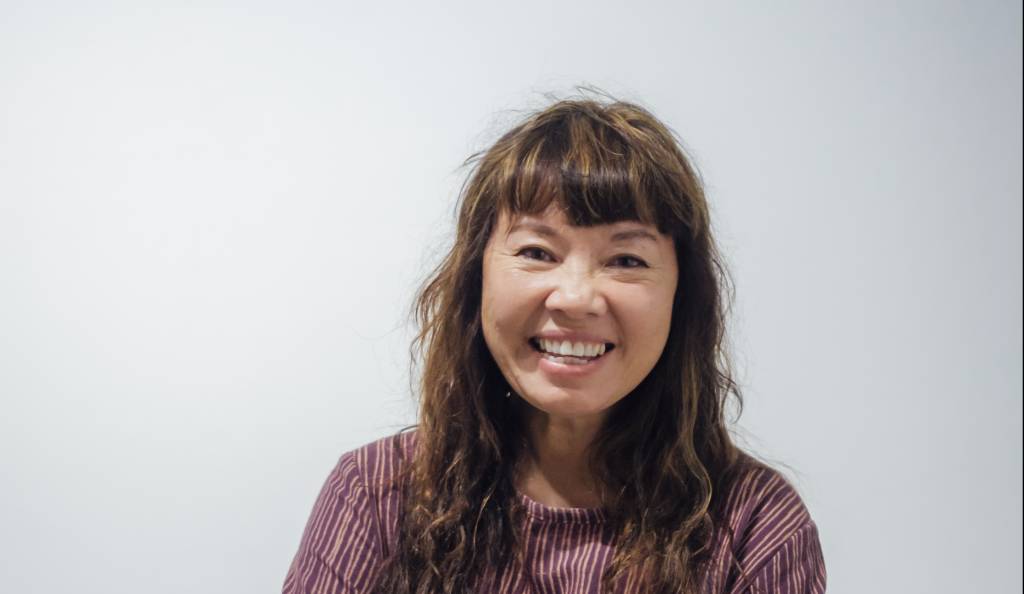GL: I’m standing in front of Cloud Galactic, a work created during your residency at STPI in 2017. It consists of coloured paper pulp on transparent acrylic discs that are interlocked and layered on top of each other. From afar, the work looks just as its title suggests, like an amorphously shaped cloud; up-close, I get the feeling of peering through some kind of lens, observing something much more intimate and cellular. The shift is quite remarkable. Was this play on perception and scale something you had envisioned for the work, or did it emerge during the making process?
SV: Thanks for rendering your encounter with Cloud Galactic from the 2017 production of the Immaculate series in this way. Yes, over the years, the body of works in my practice often choreograph this tension between convergent and divergent focus to offer the viewer an embodied experience by factoring in the interplay between the perception of scale and the scale of perception, where the approach (towards the artwork), to gain proximity or intimacy, is as important as the act of retreat (from the artwork); to apply orbiting space to take in the in situ nature of the artwork (most pertinent to the suspended installation WeCloud, and the wall-mounted piece Symphony in Blue Droplets) as much as to bring awareness to the institution of STPI as the framing device.
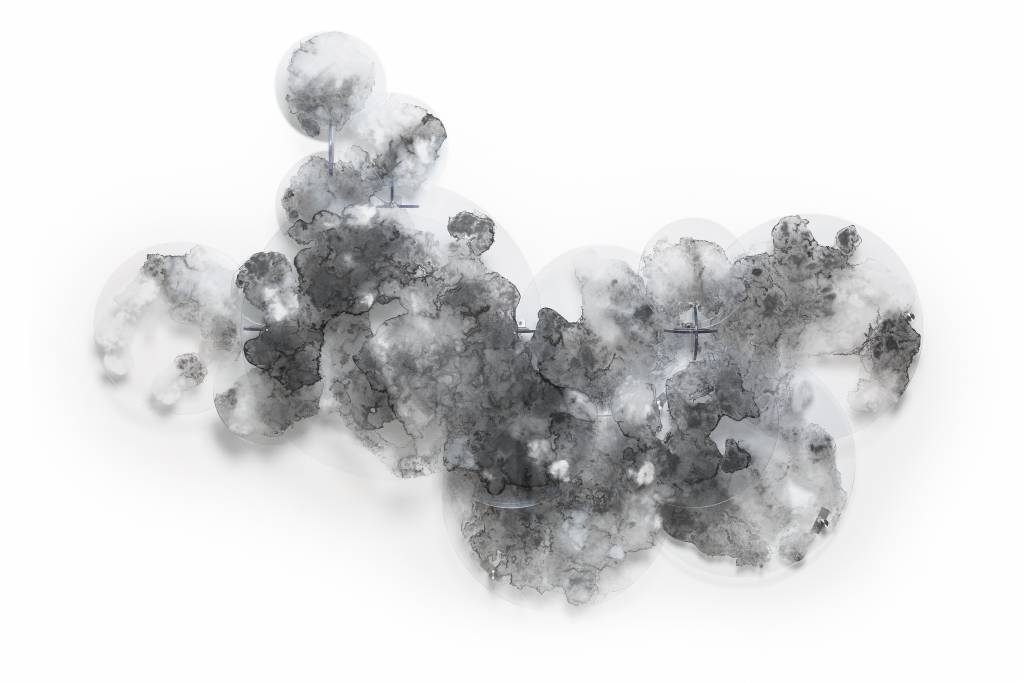
Cloud Galactic (2017), assembled polycarbonate sheets and coloured paper pulp, 100 x 136 x 18 cm. Photo courtesy of STPI.
To offer this ‘erotica’ of the eye, the WeCloud and Immaculate series is presented in an architectural format that I had designed using transparent circular discs of various diameters that overlap and interlock, such that from afar, the works appear like billowing cumulus clouds while up close, the immediacy (and intimacy) of minutiae occurs – a kind of scopic-probe of the artwork’s materiality, i.e. the naked particularities of the paper pulp fibres displayed as an intercellular matrix that give rise to either the sensation of clouds being spliced and captured onto petri-dishes or round slides, or reminiscent of the microscopic liminal world of cells making copies and copies of themselves, replicating, dividing and splitting.
The next tier of intimacy is the signature of water that is only hinted at by inversion, evident in the WeCloud, Décollage, Immaculate and Spit-Bite series. Water is elemental to STPI’s functioning as a papermaking workshop because it is water that provides the very basis for many of the paper-based works that represent the culminating efforts of artists who have passed through this creative arena. In my conceptual approach, the performance of water is a hyperlink that leads us through a continuum of artworks in the aforementioned series produced at STPI, as well as those in my wider practice such as the performance-installation Still Waters (1998) for the ARX5 event on the second-floor drain in the Singapore Art Museum, Rainbow Circle commissioned for the Singapore Biennale 2013 sited within the National Museum’s rotunda, as well as Bloodline of Peace (2015) and Third World Extra Virgin Dreams (1997), both of which incorporated a total of 14,520 donated human blood droplets whose plasma content is 91% to 92% water.
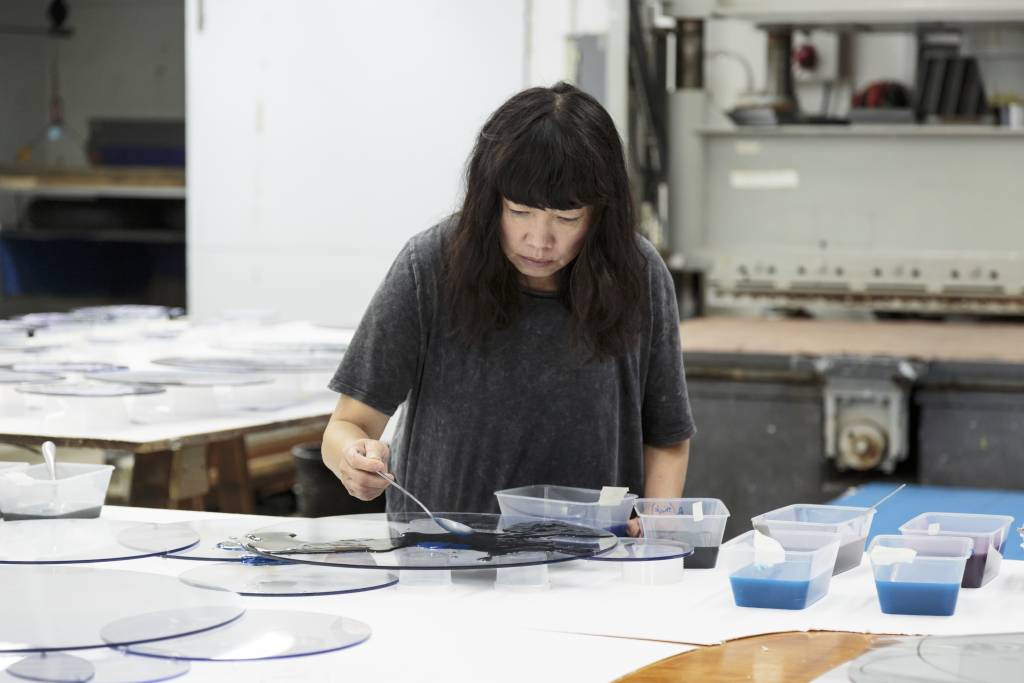
Suzann Victor during her residency at STPI in 2017. Photo courtesy of STPI.
In the WeCloud, Immaculate and Décollage series created at STPI, water is deployed as a means for transporting and depositing the constituents of paper at required destinations such as the surfaces of hundreds of acrylic discs, or the island-table-arena in the Paper Mill Room respectively. For the Spit-Bite series, water is an acid-holding medium that is loaded onto customised brushes and in turn, unleashed onto target areas of the copper plates in desired gestures, shapes and forms. The evidence, story and history of the migration of paper pulp on a journey of water, and by water, is told to you by where the fibres or acid park and mark their territory – mapping the trace of water by inversion. In exchange for often being sidelined as a mere receiving surface for mark-making, paper is wielded here not only as the active marking agent itself, but also the medium, the materiality, the content, the subject matter, the art – the heartbeat of these very works.
And so, this is the co-creative dance between water and paper pulp fibre as well as acid par excellence – the profound materiality of STPI. This vanishing act of water allows the light-filtering delicacy of pulp to take centre stage, and in my architectural way of presenting these works, even allowing you to see through two or three delicate layers of pulp at the same time. The paper’s fine, hair-like strands can be viewed directly or through the transparency of the acrylic discs, a double-sidedness that means there is no wrong side. Hence, the pulp fibres gesture back to its life force, water, because where the pulp lies belies the once-upon-a-time presence of water – its shape and size, its trails, its flows, its tributaries, every traversal, even its whisper. This is the secret life of paper pulp fibre.
GL: I’m curious about the system for making and hanging the work. The modular nature and circular form of these discs mean that unlike the compositional norms of a square or rectangle, the work is both fragmentary and multi-directional. As I understand it, you also have very loose guidelines for others to install the work as they see fit. This peculiar set of parameters makes me wonder: how one might orientate (or disorientate) oneself when encountering the work?
SV: There is a methodology of blindness in the entire process which speaks to the act of risk-taking as the foundation of creativity in this body of work, itself a disorienting process from the outset. I fed spoons and spoons of liquid-suspended pulp fibres to hundreds of acrylic discs like a child, guided only by instinct, then surrendering to the passage of time for all traces of water to vanish, only after which the basis of an eccentric sculptural grammar – a set of modular units that I had designed – was assembled like a pictogram. The individual characters, like letters of an alphabet, do not make sense on their own, but only in relation to others. No one knew, including myself, what or how each artwork was going to behave or look like until the process of meta-configuration into large scale installations occurred in situ a few days before the exhibition launch – e.g. for WeCloud and Symphony in Blue Droplets. With the suspended nature of the installation WeCloud, the multiple profiles it offers is enabled by the many shifts in viewing positions the audience is able to adopt, even overhead, in and amongst the gaps in its sprawling and hanging form. While I authorise it to be so in specific ways, other works have limited or no fixed orientation as it means a lot to me that the artwork maintains an aliveness and openness to renew and reinvigorate its relationship with the viewer as and when that occurs – a means for the artworks to transcend the fixing and framing that occurs once we name something (a series of exhibits in this case), because the act of naming can become the end of looking/seeking – a way of saying “we know” in a terminating way, reductive and conclusive – the end of inquiry.
GL: Visually, the works in this Cloud series share affinities with your early abstract paintings from the 1990s and your more recent site-specific installations like A Thousand Skies (2017) and Rising Sun (2018) for Fukuoka Asian Art Museum, partly because of the recurring motif of the lens but also in their references to landscape. Can you describe your attitude towards abstract painting as a young artist and how it felt for you to return to ‘mark-making’ and ‘painterly abstraction’ (I’m using these terms loosely here) after having moved into an expanded practice?
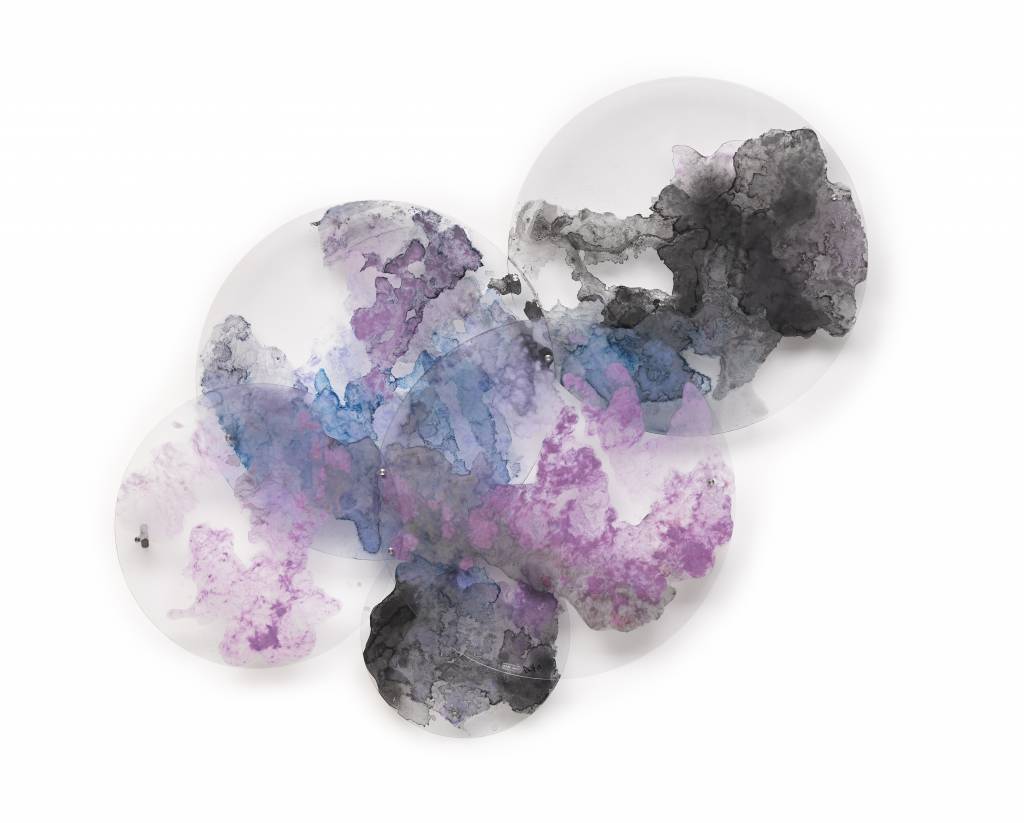
MoonCloud 4 (2017), assembled polycarbonate sheets and coloured paper pulp, 78 x 105 x 10 cm. Photo courtesy of STPI.
SV: It is interesting that you trace the lineage from my early paintings and the Cloud series to the magnification of the outerscape in the Fukuoka ‘Lens’ series, but let me include the Acid-Painting works in the Spit-Bite series, also produced at STPI.
Those early days of unashamed painterliness – sweeping gestures and broad brave strokes, the butteriness of large abstract oils – they were fired by a defiance of scale and space since architecture implicitly or explicitly influence how the scale of physical spaces are used or occupied that further shapes how intimacy, expression, gender, work, education, family and culture are transacted. For many reasons, I could see how women, like myself, start out poor in this form of currency, conditioned as we were, and still are, to occupy as little space as possible both physiologically (controlling the boundaries of the female body) or psychologically (deferential behaviour, dumbing down, limiting attention and focus on self etc.), all of which became an impetus for me to hone a practice that could outrun that kind of psyche with acts of art-making that would meaningfully occupy audiences perceptually, visually, conceptually, sensorially and bodily.
But what is also interesting about this link from early works to the aforementioned series is the inversion; the crepuscular, wind-swept, hewn, mottled, undulating, hurried, fecund, flowing, luxuriant stillness, (disquiet and bleakness at times) of the large oil abstracts of the 90’s poured out of my shoulder joint (rather than the wrist) as the centre of turbulence, oozing with my interiority that was in effect extracted from the exterior physical world in the first, now returned to the canvas, acrylic or copper surfaces, while the Cloud series and the Acid-Painting prints were achieved out of hand labour with the wrist as the pivoting joint, spoon-feeding hundreds of acrylic discs as mentioned before in the Cloud series, or loading customised brushes with acid to unleash on copper plates in the case of the Acid-Painting series.
Where the Fukuoka Lens series is concerned, the effects of inversion as well as the interplay of scale versus perception mentioned earlier are likewise activated. The assembled Fresnel lens architecture of the outdoor pavilion in A Thousand Skies enabled the viewer’s private world of communing with nature to be carved out of public space, where the tranquil stillness of the surroundings – the 1000 year old Jyotenji temple architecture, worshippers and visitors alike, moss, dropping leaves, trees, insects, cherry blossoms of the Sakura Season to the azure, blue winter skies – were poured into each lens in a repeat of extremes and hallucinatory magnification, closing the gap between the expanse of the heavens and earth because what is viewed through those lenses somehow became closer sensorially, visually and perceptually. Here, the viewer was in control to change views through those very same lenses by the subtlest of tilts, angles or turns in order to change vistas. And so, the audience drinks in the beauty of not only the immediate environment but also the presence of time, the now. The intensive hand labour of tightening nuts and bolts to assemble enormous quantities of lenses were painstakingly carried out by a team of assistants supervised by the Japanese curator Yuko Yamaki and architect Akio Tokunaga.
GL: The sense of the body has always been very palpable in all your work, whether it’s the presence of the physical body in your live performances such as Still Waters (1998) or through its absence and trace in installations like Third World Extra Virgin Dreams (1997). The body in your work often appears still, haunting and/or trapped in liminal spaces. Looking at the Cloud series, there is also a similar sense of embodiment (or is it disembodiment? – I find myself oscillating between the two). Was that something conscious? And has this sense of the ‘body’ changed for you in any way over the years?
SV: I think that my approach to art-making is really predicated upon the body as a site of meaningful social, political, aesthetic and conceptual encounter, and as much a tool or a weapon for apprehending the world. Yes, my works feature the bandwidth of the body’s absent presence – present absence that has become very much a part of my practice. In our conversation, I described to you my situated subjectivity of disembodiment that arose out of the swift de facto ban imposed upon performance art by the state in 1994 – a punitive action that saw two prohibitive conditions imposed upon artists: the requirement for written scripts (to control the unscripted, and therefore, unpredictable nature of performance art) with a $10,000 deposit to be submitted to the police for approval (generally unaffordable for artists, hence proving to be effective deterrent against performance as cultural production for a decade).
I have always described this period as a discourse of trauma, one that I processed through the writing of my dissertation later on due to my then direct involvement as the Artistic Director of 5th Passage. But whilst in the eye of the storm, I presented performative-installations that reeked of the body even in the face of its mandated absence such as His Mother is a Theatre (1994), and as you mentioned, Still Waters (between estrangement and reconciliation) and Third World Extra Virgin Dreams (1997, 6th Havana Biennial) amongst many others. So, His Mother is a Theatre (1994) can be attributed as one of a set of three precursor works that testified to the lived reality of disembodiment, compelled, as I was, by a call to respond unambiguously to the proscription of performance art that year, and by extension, the banishment of the artist’s body in cultural production. It was predicated upon creating an intentional mis-take of these new laws by offering the required ‘script’ for cultural policing as a self-authoring body that uses its own corporeal materiality, in this case hair and its DNA, to write its self into public space in all its inner and outer nudity. In so doing, the work presented a body that has exceeded its own margins – an open interior where the insides have spilt over onto the outside in a vertigo of concentric rings arranged on the floor, abject and splayed out – a visual quotation of a broken body performing a fragmented message to the Singapore state. The donated wisps of black human hair were meticulously groomed into signifiers that portray the inner theatre of female sexual and reproductive corporeality, explicitly naming and signing off its many parts – e.g. ‘clitoris’, ‘mammary glands’, ‘vulva’, ‘ovaries’, and so on – as a body in pieces, literally acting out the compulsory script for approval except that it was not tendered to the police but to the public at Pacific Plaza where it occupied a large vacant shop lot, 5th Passage’s second home after eviction from Parkway Parade.
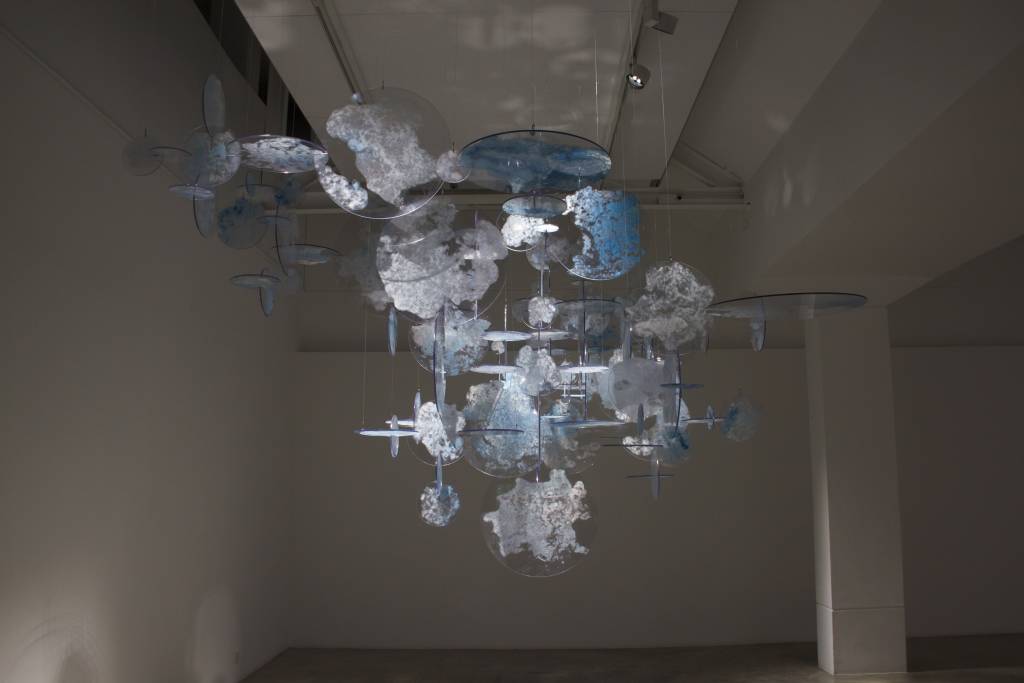
Installation view of WeCloud (2015), paper pulp, discs, metal rings, and monofilament, dimensions variable. Photo courtesy of STPI.
The Cloud series however presses home the idea of the body as the locus of disorientation and distortion but also intimacy. By presenting the migratory journey of ultra-fine strands of paper pulp, its colour, composition, texture and gesture as a map of movement on the surfaces of large circular discs, it recalls the experience of surveying near-invisible topographic terrains at extreme elevation (or being amongst clouds) except without ever leaving the earth-plane, thus offering the sensation of a gravity-defying body and/or conversely, peering into the strange cellular intimacy of strand-like bacteria except without a microscope, this time with the sensation that one’s body has shrunk down in scale such that a laboratory slide, usually a few centimetres across, is now ten times bigger in size!
Click here to return to Strange Forms of Life: Resource Centre
